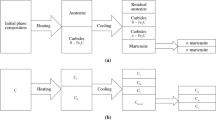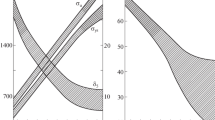Conclusion
A brief summary of some previously published results on quantitative relationships between the parameters of the microstructure and the mechanical properties has been presented — in this case the yield strength. The relationships presented make it possible in some cases to explain the influence of the chemical composition and the characteristics of the production process on the properties of steels. They are also the basis for the production of metals with desired properties.
The contribution of various elementary effects to the strength characteristics of steels is one of the basic questions in physical metallurgy. In recent years there have been advances not only in the theory of hardening and in the identification of various mechanisms of hardening but also in practical application of theoretical data. This is confirmed by the development of maraging steels, the use of various mechanisms of hardening in controlled rolling of microalloyed steels, progress in thermomechanical treatment of steels, the first experiments in quenching steels from the liquid condition, and the development of new types of heat-resistant steels.
Similar content being viewed by others
Literature cited
T. Prnka, Arch. Eisenhuttenw.,42, 919 (1971).
D. Smith and R. Hehemann, J. Iron Steel Inst.,209, 476 (1971).
L. Raymond and W. Reuter, Acta Met.,12, 948 (1964).
T. Greday and A. Lutts, C. N. R. M., 8, 29 (1966).
E. Hornbogen, Proc. ICSTIS, Suppl. Trans. ISIJ,11, 997 (1971).
A. Kelley and R. Nicholson, "Precipitation hardening," in: Progress in Material Science, Vol. 10, Pergamon Press (1963).
L. Brown and R. Ham, "Strengthening methods in crystals," in: Dislocation-Particle Interaction, A. Kelly and R. Nicholson (editors), Elsevier, London (1971), p. 9.
J. Friedel, Dislocations, Pergamon Press, London (1964).
E. Orowan, Symposium on Internal Stresses in Metals and Alloys, Inst. of Metals, London (1948). p. 451.
T. Prnka, Kovove Materialy,7, 328 (1969).
K. Westmacott, C. Fountain, and R. Stirton, Acta Met.,14, 1628 (1966).
U. Kocks, Acta Met.,14, 1629 (1966).
Kvantitativni Stereometricka Metalografie CVTS-SCH, Praha (1971).
T. Prnka, Ceskoslovensky Casopis pro Fyziku,19A, 8 (1969).
G. Knowles and P. Kelly, Effect of Second-Phase Particles on the Mechanical Properties of Steel, The Iron and Steel Institute, London (1971), p. 1.
U. Kocks, Physics of Strength and Plasticity, A. Argon (editor), MIT Press (1969), p. 143.
F. Pickering and T. Gladman, Metallurgical Developments in Carbon Steels, Spec. Report 81, The Iron and Steel Institute, London (1963), p. 10.
T. Kunitake, Trans. Iron Steel Inst. Japan,7, 254 (1967).
A. Cox, J. Iron Steel Inst.,205, 51 (1967).
K. Nishida, Trans. Iron Steel Inst. Japan,9, 313 (1969).
N. Hansen and H. Lilholt, Matrix Hardening in Dispersion Strengthened Powder Products, Modern Developments in Powder Metallurgy, H. Hausner (editor), Plenum Press (1971), p. 339.
D. Smith and R. Hehemann, J. Iron Steel Inst.,209, 476 (1971).
J. Sobotka and T. Prnka, Arch. Eisenhuttenw.,45, 629 (1974).
Additional information
Scientific-Research Institute of Ferrous Metallurgy, Dobra, Czechoslovakia. Translated from Metallovedenie i Termicheskaya Obrabotka Metallov, No. 7, pp. 3–8, July, 1975.
Rights and permissions
About this article
Cite this article
Prnka, T. Quantitative relationships between the parameters of dispersed precipitates and the mechanical properties of steels. Met Sci Heat Treat 17, 548–552 (1975). https://doi.org/10.1007/BF00680398
Issue Date:
DOI: https://doi.org/10.1007/BF00680398




